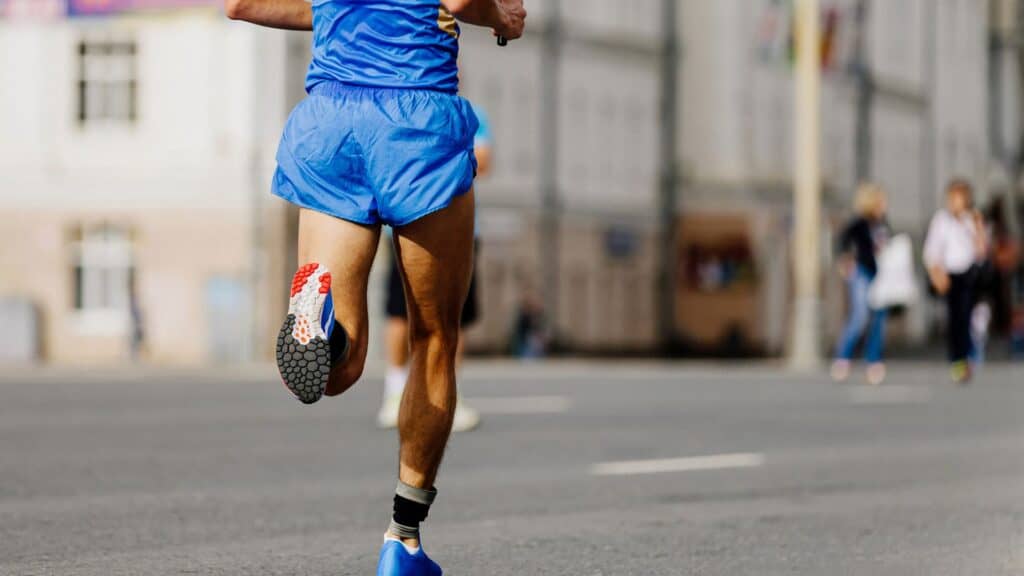The Boston Marathon is like the ultimate dream for marathon runners.
It’s not just any race you can simply sign up for – you’ve got to be lightning-fast to qualify. And even if you do meet the qualifying time, there’s no guarantee you’ll snag one of those precious 30,000 race bibs.
Maybe you watched those inspiring runners on Patriots’ Day, and now you’re getting ready for a spring marathon, hoping to qualify for the 2025 Boston Marathon. It’s important to note that the Boston Marathon takes place in the spring, in April, which means the qualifying races are usually held in the fall (autumn) of the previous year.
But here’s the thing: the qualifying times keep getting faster each year, which means even if you run a qualifying time, you might still miss out on a bib. It’s a first-come, first-served kind of deal. Tricky, huh?
To qualify for the prestigious Boston Marathon, you need to meet specific qualifying time standards based on your age and gender. The qualifying times are challenging, requiring runners to achieve fast race paces. For example, a male runner aged 18-34 must complete a marathon in under 3 hours to qualify, while a female runner in the same age group must finish in under 3 hours and 30 minutes.
These time standards ensure that the race maintains its competitive nature and attracts top runners from around the world.
If you aspire to participate in the Boston Marathon, it’s essential to train diligently and strive to meet the rigorous qualifying times set by the organizers.

What Are The Qualifying Time Standards For Each Age Group?
Qualifying for the Boston Marathon is no small feat.
To ensure fairness and competitiveness, the Boston Athletic Association (B.A.A.) sets specific qualifying time standards for each age group.
These standards vary based on age and gender, reflecting the diverse range of participants. Let’s dive into the qualifying times across different age brackets.
The table below displays the specific qualifying times from previous years for the Boston Marathon. However, it’s important to note that entry criteria are updated annually, so for the most accurate and up-to-date information, please refer to the official Boston Marathon website.
| Age Group | MEN | WOMEN | NON-BINARY |
|---|---|---|---|
| 18-34 | 3hrs 00min 00sec | 3hrs 30min 00sec | 3hrs 30min 00sec |
| 35-39 | 3hrs 05min 00sec | 3hrs 35min 00sec | 3hrs 35min 00sec |
| 40-44 | 3hrs 10min 00sec | 3hrs 40min 00sec | 3hrs 40min 00sec |
| 45-49 | 3hrs 20min 00sec | 3hrs 50min 00sec | 3hrs 50min 00sec |
| 50-54 | 3hrs 25min 00sec | 3hrs 55min 00sec | 3hrs 55min 00sec |
| 55-59 | 3hrs 35min 00sec | 4hrs 05min 00sec | 4hrs 05min 00sec |
| 60-64 | 3hrs 50min 00sec | 4hrs 20min 00sec | 4hrs 20min 00sec |
| 65-69 | 4hrs 05min 00sec | 4hrs 35min 00sec | 4hrs 35min 00sec |
| 70-74 | 4hrs 20min 00sec | 4hrs 50min 00sec | 4hrs 50min 00sec |
| 75-79 | 4hrs 35min 00sec | 5hrs 05min 00sec | 5hrs 05min 00sec |
| 80 and over | 4hrs 50min 00sec | 5hrs 20min 00sec | 5hrs 20min 00sec |
Boston Marathon Qualifying Times: Can You Make the Cut?
You may be inspired by the fact that more than 30,000 athletes worldwide qualify for the Boston Marathon, making you believe that you can achieve it too.
To participate in the Boston Marathon, you must meet the qualification requirements within a 12-month period prior to the September registration date for the April race.
This implies that you need to attain a qualifying time between approximately 7 and 19 months before the April race.
The qualifying window for the 129th Boston Marathon, scheduled to take place on April 21, 2025, began on September 1, 2023. Registration details for that race will be announced following the 2024 Boston Marathon.
Below, you can find the cut-off time limits from previous years. Notably, there was no cut-off time limit for the 2022 and 2023 Boston Marathon, meaning that all runners with a valid qualifying time were accepted into the race.
| YEAR | FIELD SIZE | “CUT-OFF TIME” | QUALIFIERS NOT ACCEPTED |
| 2012 | 27,000 | 1:14 | 3,228 |
| 2014 | 36,000 | 1:38 | 2,976 |
| 2015 | 30,000 | 1:02 | 1,947 |
| 2016 | 30,000 | 2:28 | 4,562 |
| 2017 | 30,000 | 2:09 | 2,957 |
| 2018 | 30,000 | 3:23 | 5,062 |
| 2019 | 30,000 | 4:52 | 7,248 |
| 2020 | 31,500 | 1:39 | 3,161 |
| 2021 | 20,000 | 7:47 | 9,215 |
I’ve Run a Boston Marathon Qualifying Time — What Are My Chances Of Getting In?
While achieving the qualifying time for the Boston Marathon is a significant accomplishment, it does not guarantee you a spot in the race. This is because the number of available race bibs is limited.
To determine the participants, the fastest runners in each age and gender group are accepted if the total number of submissions exceeds the allotted field size for qualified athletes.
Registration occurs over a two-week period, with the fastest runners given priority during the first week. Following that, runners who have beaten their qualifying time by 20, 10, or 5 minutes will have the opportunity to register.
Now that we have a solid understanding of the challenges involved in qualifying for the Boston Marathon and the significance of speed, let’s look into the strategies that can help you improve your speed and decrease your race times.
Let’s dive in…
How Can I Improve My Speed and Decrease My Race Times?
When it comes to the Boston Marathon, speed is of paramount importance.
To achieve your best race time and qualify for this prestigious event, you need to focus on strategic training techniques and fine-tune your running performance.
Here are some effective strategies that can help you elevate your speed and cut those valuable seconds off your race times:
- Ensure that you are doing easy runs in the correct zone
- Incorporating Interval Training,
- Adding Strength Training,
- Gradually Increasing Your Mileage
- Cross-Train
- Hydrate & Fuel
- Get Enough Rest and Recovery

Incorporating Interval Training
If you’re looking to boost your running speed, interval training is a useful tool! Interval training involves alternating between intense running and periods of rest or lower-intensity activity.
By incorporating this training technique, you can improve your musculoskeletal coordination, range of motion, and anaerobic metabolism.
Before you dive headfirst into interval training, it’s important to have a solid running foundation.
Take some time to establish a consistent running routine that you feel comfortable with. Once you’ve got that down, you can start sprinkling shorter intervals into your workouts.
As an example, try increasing your pace to a 5km race pace for 30 seconds and then giving yourself a breather with 1–2 minutes of easy running.
Here’s the key: don’t feel like you have to go all-out during each interval. Start off gradually and let your body adjust. Over time, you can gradually increase the length and intensity of your intervals.
The important thing is to listen to your body and avoid pushing yourself too hard, especially if you’re new to running.
Adding Strength Training
Strength training is an absolute game-changer for runners aiming to up their performance and stay injury-free. One of the most significant advantages is injury prevention.
By ensuring the correct function of smaller muscle groups, strength training helps stabilize your body and avoids larger muscles taking over, leading to misalignment and potential injuries.
Strength training also boosts a runner’s economy by a notable 4%–6%, depending on factors like training level and the type and frequency of strength workouts.
This means you’ll be able to go further and with greater efficiency, using less energy in the process. Plus, it helps stave off fatigue, keeping you going strong.
When it comes to incorporating strength training into your routine, aiming for two to three sessions per week is ideal. I know it might feel like there’s not enough time, but trust me, it’s worth it for injury prevention and performance enhancement.
This has been one of the biggest impacts on my personal running over the past 2 years, when I have been consistent with strength training, I have run pain-free and put my best training blocks together. So much so that I will now skip running sessions before I skip strength training.
And don’t forget about periodisation! Balancing your strength training with your running regimen is key. It’s all about building a solid foundation and complementing your overall training plan.
Check out this video, where we share with you an insanely simple, 5-exercise routine that every busy runner should incorporate into their training.
It’s a game-changer for those who are constantly on the go but still want to boost their running performance.
Gradually Increasing Your Mileage
Here’s a valuable tip to enhance your running speed and endurance: gradually increase your mileage.
Building up your distance slowly and sticking to a maximum 10% weekly increase is a smart move to avoid injuries. Remember, consistency is key!
Don’t underestimate the power of walking breaks! Introducing short walk breaks into your running sessions can actually help you sustain your mileage over time.
It’s a smart way to give your body a breather while still making progress.
Cross-Train
Incorporating cross-training into your training plan is a game-changer for your Boston Marathon preparation. Particularly as you get older or if you are fairly new to marathon running.
It’s a key element that adds variety to your workouts and helps minimize the strain on your body. While running focuses on high-impact movements, cross-training allows you to engage in activities that provide cardiovascular benefits and load your muscles without subjecting them to excessive stress.
So, what are some fantastic cross-training options to consider? Here are a few that can complement your running routine and give you that extra edge:
1. Cycling: Hop on a bike and enjoy a low-impact, yet highly effective, cardiovascular workout that strengthens your leg muscles without the pounding of running. (Cycling To Run FASTER: How To Use Your Bike To Become A Better Runner)
2. Swimming: Dive into the pool for a refreshing and joint-friendly workout that engages your entire body, improves cardiovascular fitness, and enhances muscular endurance. (Revealed: How To Swim Your Way To Becoming A Better Runner)
3. Elliptical: Take advantage of this low-impact machine that mimics the natural motion of running without the impact on your joints. It provides a great cardio workout while engaging your lower body muscles.
4. Rowing: Get your heart pumping and build both upper and lower body strength with rowing. This full-body workout helps improve endurance and is a fantastic option for cross-training.
5. Yoga: Enhance your flexibility, core strength, and balance through practicing yoga. It not only complements your running by improving posture and alignment but also promotes mental focus and relaxation.
This is another area that I have found to work very well. During my years as a triathlete, I improved my running enormously, and I put that down to the reduction in eccentric load from cycling and swimming. As I am getting older, I am reincorporating some cycling and swimming to improve cardiovascular conditioning with a lower load on joints and muscles.
Hydrate & Fuel
Achieving peak running performance goes beyond training and technique; it requires proper nutrition and hydration to support your body.
To optimize your performance, it’s crucial to provide your body with the right fuel and hydration.
If you’re following a low-carb diet, consider incorporating non-carbohydrate sources like fat into your runs. Additionally, make it a priority to refuel your muscles within the first 30 minutes after exercise to replenish glycogen stores.
Before long runs, plan a high-carb meal consisting of nutrient-dense foods. This will help sustain your energy levels throughout the run.
During your training, it’s essential to experiment with different fuelling options to find what works best for you. If you’re experiencing low energy levels, consider increasing your fuel intake during exercise.
Remember, fuelling during long runs is crucial for maintaining energy levels and preventing muscle fatigue.
Find a balance that works for you and prioritize proper nutrition and hydration to enhance your running performance. Your body will thank you for the fuel it needs to reach new heights!
Get Enough Rest and Recovery
Rest and recovery are vital aspects of optimizing and supporting your body’s adaptation to the demands of running.
To ensure your body receives the necessary rest and recovery, it’s essential to incorporate scheduled rest days into your training plan.
Additionally, engaging in activities that promote recovery, such as foam rolling, stretching, and massage, can be beneficial.
Rest days tend to be underestimated by many runners, but they are integral to any training plan. They provide a valuable opportunity for our bodies to adapt and progress based on the completed training. Without sufficient recovery, we risk compromising the full benefits of our training efforts.
Giving yourself time to recover after runs is crucial for returning stronger and better prepared for your next session.
Prioritizing rest and recovery is just as important as focusing on your training sessions.
Research even suggests that chocolate milk can be a cost-effective and beneficial alternative to expensive recovery products, as it can extend training exhaustion time and aid in muscle repair.
For more insights and a detailed discussion on the topic, you can watch our video “Is Chocolate Milk A Great Recovery Drink For Runners?” where we delve into the scientific aspects and explore the study further.
Neglecting recovery increases the risk of injury and illness and hampers overall performance. When we exercise, we cause minor damage to our system. Recovery is the phase when the body repairs this damage and makes improvements, enabling us to handle more load in subsequent exercises.
These incremental improvements contribute to enhanced fitness, speed, and strength. Without adequate recovery, we impede the complete repair and compensation necessary for effective training.
In the blog post “Is Sleep Important For Runners: Facts To Improve Your Running,” we delve into how a good night’s sleep can significantly impact your race day performance.
Read on to discover the importance of quality sleep and how it can make a difference in your overall running performance.

Which Races Are Certified For Boston Marathon Qualification?
When it comes to qualifying for the prestigious Boston Marathon, not all races are created equal.
To secure your spot in this iconic event, you must complete a certified marathon that meets specific criteria set by the Boston Athletic Association (BAA).
Here’s what you need to know about the races that qualify for the Boston Marathon qualification.
- Certification Process: The BAA certifies races by carefully evaluating their course accuracy, measurement methodology, and adherence to standard regulations. Certified races provide accurate distances, ensuring fair competition for all participants.
- USATF Certification: The United States of America Track and Field (USATF) is responsible for certifying races within the United States. To be eligible for the Boston Marathon qualification, a race must have USATF certification.
- International Races: Outside the United States, international marathons can also be certified by their respective national athletic governing bodies. These races must meet the BAA’s stringent standards to be recognized for Boston Marathon qualification.
- Qualifying Time Validation: Regardless of the race’s certification, achieving a qualifying time is essential. You must complete a certified marathon within a specific time frame based on your age and gender category to be considered for the Boston Marathon.
Top Boston Qualifying Races
The list below does not indicate the number of individuals who achieve a qualifying performance at each specific event. It also does not provide a comprehensive compilation of marathons used for Boston Marathon qualification.
- Boston Marathon: The iconic Boston Marathon itself is one of the most prestigious races to qualify for, with its challenging course and rich history.
- Chicago Marathon: Known for its flat and fast course, the Chicago Marathon attracts many runners aiming for a Boston qualifying time.
- New York City Marathon: As one of the largest marathons in the world, the New York City Marathon offers a diverse and exciting route that has seen numerous Boston qualifiers.
- California International Marathon: This race in Sacramento, California, has a reputation for its fast course and favorable weather conditions, making it a popular choice for runners aiming to qualify for Boston.
- Philadelphia Marathon: With its flat and scenic course, the Philadelphia Marathon has been a favorite among runners looking to achieve their Boston qualifying times.
- Erie Marathon: Known for its flat and fast course, the Erie Marathon in Pennsylvania provides an opportunity for runners to chase their Boston qualifying goals.
- Mountains 2 Beach Marathon: Nestled in California, this marathon offers a net downhill course with breathtaking views, attracting runners aiming for a fast time and a chance to qualify for Boston.
- Revel Mt. Charleston Marathon: Taking place in Nevada, this marathon is known for its fast, downhill course, providing an excellent opportunity for runners seeking a Boston qualifying time.
- Berlin Marathon: As one of the World Marathon Majors, the Berlin Marathon offers a flat and fast course through the vibrant streets of Berlin, attracting elite runners and amateurs alike striving for a Boston qualifying performance.
- Indianapolis Monumental Marathon: This race in Indiana boasts a flat and scenic course, making it a popular choice for runners looking to achieve their Boston qualifying times.
- Twin Cities Marathon: Held in Minnesota, the Twin Cities Marathon combines beautiful scenery with a supportive atmosphere, making it a favourite among runners aiming for a Boston qualifying time.
- London Marathon: Another World Marathon Major, the London Marathon takes participants through the streets of the UK capital, offering a mix of iconic landmarks and enthusiastic crowds, creating an unforgettable experience for those seeking a Boston qualifying opportunity.
- St. George Marathon: Set against the backdrop of Utah’s stunning landscapes, the St. George Marathon challenges runners with its hilly yet rewarding course, attracting those looking to achieve their Boston qualifying times.
- Lehigh Valley Via Marathon: Held in Pennsylvania, the Lehigh Valley Via Marathon offers a scenic course and favourable conditions for runners aiming to qualify for Boston.
- Richmond Marathon: Known for its scenic course and friendly atmosphere, the Richmond Marathon in Virginia has been a popular choice for runners pursuing their Boston qualifying goals.
- Grandma’s Marathon: Held in Duluth, Minnesota, Grandma’s Marathon offers a scenic route along the picturesque North Shore of Lake Superior, providing an opportunity for runners to achieve their Boston qualifying times.
- Ottawa Marathon: Taking place in Canada’s capital city, the Ottawa Marathon offers a fast and flat course that has witnessed many runners achieving their Boston qualifying goals.
- Mesa Marathon: Previously known as the Mesa-Phoenix Marathon, it’s known for its fast course and typically favorable weather conditions, the Phoenix Marathon in Arizona is a popular choice for runners aiming to qualify for Boston.
- Baystate Marathon: Located in Massachusetts, the Baystate Marathon offers a flat and fast course, attracting runners seeking to achieve their Boston qualifying times.
- Steamtown Marathon: Set in Scranton, Pennsylvania, the Steamtown Marathon is known for its downhill course and supportive atmosphere, making it a popular choice for runners seeking a Boston qualifying time.
The Boston Marathon Association is happy to accept races that are on net Downhill so if you are marginal on the qualifying time, select an event that aids you with a downhill course. Be warned that while faster, this does a lot more damage, and therefore strength training is even more important.
Exercises like toe raise and forward & lateral band walks, for example, are perfect. Our free strength training plan is a great place to start and you can download it by clicking here.



Comments are closed.